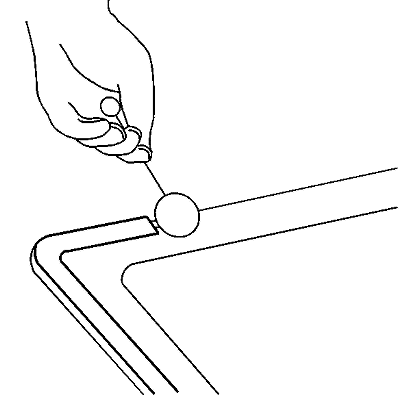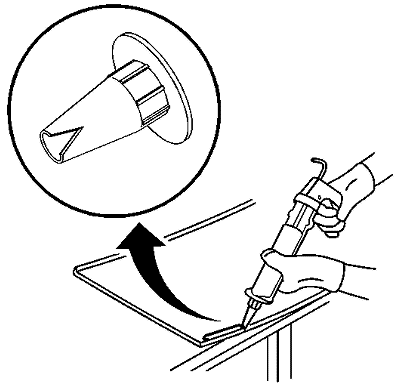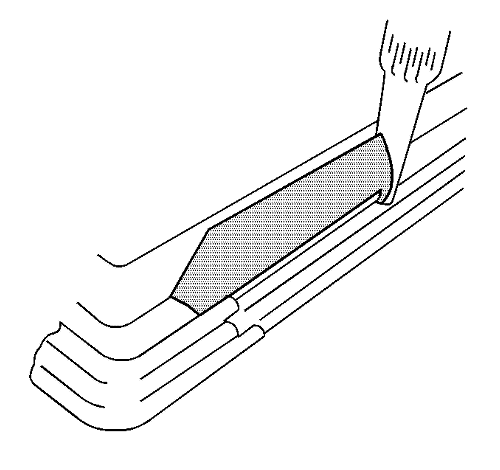Warning: Refer to Glass and Sheet Metal Handling Warning in the Preface section.
- Use a urethane adhesive systems which meet GM Specification GM 3651G
- Remove all mounds or loose pieces of urethane adhesive from the pinchweld area.
- If the original window is being reused, remove all but approximately 2 mm (3/64 in) of the existing bead of urethane adhesive from the pinchweld flange by using a clean utility knife or razor blade scraper.
- Inspect for any of the following problems in order to help prevent future breakage of the window:
| • | The flange of the window opening |
| • | Any other obstruction or irregularity in the pinchweld flange |
Note: If corrosion of the pinch-weld flange is present or if sheet metal repairs or replacements are required, the pinch-weld flange must be refinished in order to restore the bonding area strength. If paint repairs are required, mask the flange bonding area prior to applying the colour coat in order to provide a clean primer only surface. Materials such as BASF DE15®, DuPont 2610®, Sherwin-Williams PSE 4600 and NP70® and Martin-Semour 5120 and 5130® PPG DP90LF SPIES/HECKER 3688/8590 - 3688/5150 - 4070/5090 STANDOX 11158/13320 -- 14653/14980 products are approved for this application.
- After repairing the opening as indicated, perform the following steps:
- Use an abrasive pad if necessary to remove mold release buildup from the encapsulated window. Use a dampened lint free cloth to remove any debris remaining on the window.

- Dry fit the window (1) to the opening in order to determine the correct position.
- Ensure that the window locator pins are positioned to the pinch-weld flange.
- Use masking tape to mark the locations of the window in the opening.
- Cut the masking in the centre and remove the window from the opening.
- Verify all primers and urethane adhesive are within expiration dates.

Warning: Failure to prep the area prior to the application of primer may cause insufficient bonding of urethane adhesive. Insufficient bonding of urethane adhesive may allow unrestrained occupants to be ejected from the vehicle resulting in personal injury.
Note: Do not apply the black #3 primer to the existing bead of the urethane adhesive on the pinch-weld flange. Apply the primer only to nicks, scratches or the primed surfaces.
- Shake the primer clear #4 for at least 1 minute.
- Use a new dauber in order to apply the primer to the surface of the encapsulated window.
- Allow the primer to dry for approximately 6 minutes.

- Cut the applicator nozzle in order to provide a bead of 8 mm (0.31 in) wide, 12 mm (0.50 in) high.

- Use a cartridge-type caulking gun in order to apply a smooth, continuous bead of urethane adhesive.
- Use the edge of the inside encapsulated window track as a guide for the nozzle in order to apply the urethane adhesive.
- Place the window in the opening.
- Align the masking tape lines on the window and the body.
- Press firmly around the entire periphery of the window in order to wet-out the urethane bead.
- Tape the window to the body in order to minimise movement until the urethane adhesive cures.
- Clean any excess urethane adhesive from the body.
Note: Do not direct a hard stream of high pressure water to the freshly applied urethane adhesive.
- Use a soft spray of warm water in order to immediately water test the window.
- Inspect the window for leaks.
- If any leaks are found, use a plastic paddle in order to apply extra urethane adhesive at the leak point.
- Retest the window for leaks.
Warning: Insufficient curing of urethane adhesive may allow unrestrained occupants to be ejected from the vehicle resulting in personal injury.| • | For the moisture-curing type of urethane adhesive, allow a minimum of 6 hours at 21°C (70°F) or greater and with at least 30 percent relative humidity. Allow at least 24 hours for the complete curing of the urethane adhesive. |
| • | For the chemical-curing type of urethane adhesive, allow a minimum of 1 hour . |
- Maintain the following conditions in order to properly cure the urethane adhesive:
| • | Partially lower a door window in order to prevent pressure buildups when closing doors before the urethane adhesive cures. |
| • | Do not drive the vehicle until the urethane adhesive is cured. Refer to the above curing times. |
| • | Do not use compressed air in order to dry the urethane adhesive. |
- Complete the window installation.



